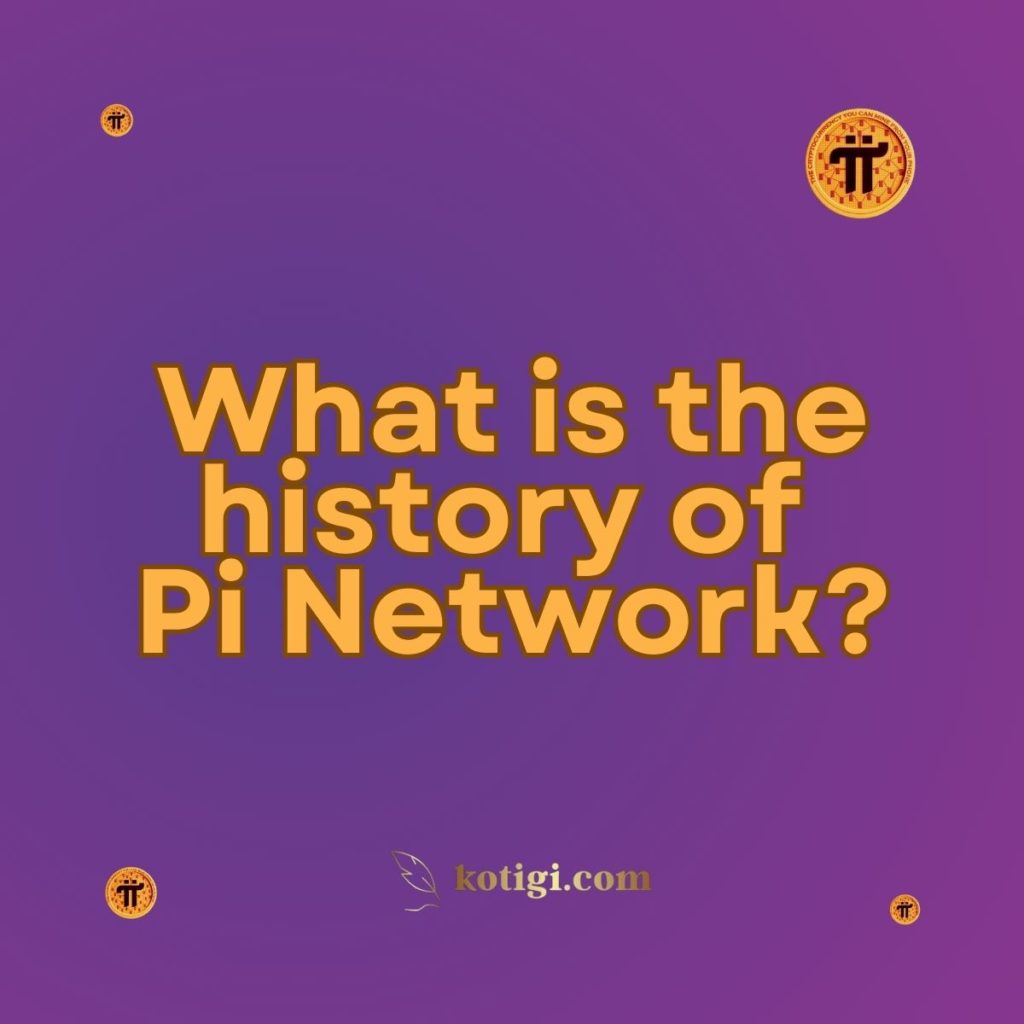
What is the history of Pi Network?
The Pi Network, launched in 2019 by a team of Stanford graduates, has evolved from a mobile mining platform into a decentralized cryptocurrency ecosystem, gaining millions of users and aiming for a sustainable digital currency through innovative technology and community engagement.
Introduction
In the ever-evolving landscape of cryptocurrency, numerous projects have emerged, each with unique features and goals. One such initiative is the Pi Network, which aims to make cryptocurrency accessible to everyone through a user-friendly mobile mining platform. Founded by a team of Stanford graduates, Pi Network has rapidly gained popularity, attracting millions of users worldwide. This blog post delves into the history of Pi Network, exploring its inception, development milestones, and the vision that has propelled it into the spotlight.
Understanding the history of Pi Network is crucial for grasping its current position in the cryptocurrency market and its future potential. From its early days as a concept to its growth into a community-driven ecosystem, Pi Network represents a significant evolution in how individuals engage with cryptocurrency. In this comprehensive overview, we will trace the journey of Pi Network from its beginnings to its aspirations for the future.
1. The Inception of Pi Network
Founding Team and Vision
Pi Network was founded in March 2019 by a group of Stanford graduates: Nicolas Kokkalis, Chengdiao Fan, and Vince McPhillip. Their vision was to create a cryptocurrency that would be accessible to everyone, even those without prior experience in the blockchain space. The founding team recognized that traditional cryptocurrency mining processes were often complicated and required substantial technical knowledge and resources, limiting participation to a small group of individuals.
To address this challenge, the founders aimed to design a mobile application that would allow users to mine cryptocurrency using their smartphones. This concept revolved around the idea that everyone should have the opportunity to participate in the digital currency revolution, leading to the creation of the Pi Network.
Launch of the Mobile App
In March 2019, the Pi Network launched its mobile app, allowing users to start mining Pi coins with just a few taps on their smartphones. The app was designed to be intuitive and user-friendly, making it accessible to a broad audience. This innovative approach differentiated Pi Network from many other cryptocurrency projects, as it eliminated the need for expensive hardware and complex setups.
The launch of the mobile app marked the beginning of Pi Network’s journey, attracting a wave of early adopters eager to participate in this novel approach to cryptocurrency mining. The simplicity of mining Pi coins on a mobile device quickly garnered attention and fueled interest in the project.
Building a Community
From the outset, the Pi Network emphasized community engagement as a core principle. The founders understood that the success of the network would rely heavily on building a strong and active user base. To foster this sense of community, they implemented features such as social networking elements within the app, allowing users to connect, share their experiences, and invite others to join.
The community-driven approach not only helped in spreading awareness about Pi Network but also created a sense of belonging among users. As more individuals joined the platform, the network’s growth accelerated, laying the foundation for its future developments.
2. Growth and Milestones
Rapid User Adoption
Following the launch of the mobile app, Pi Network experienced rapid user adoption. Within the first year, millions of users had signed up to mine Pi coins, creating a vibrant community of Pioneers. The app’s unique mining mechanism allowed users to earn Pi coins without the need for advanced technical knowledge or expensive equipment, making it appealing to a wide audience.
This rapid growth can be attributed to several factors, including the app’s simplicity, the promise of a new cryptocurrency, and the strong emphasis on community engagement. Users were motivated not only by the prospect of earning Pi coins but also by the opportunity to be part of a revolutionary project.
Phases of Development
As Pi Network grew, the team introduced several phases to its development process. The project was divided into three main phases: the testnet phase, the mainnet phase, and the ecosystem phase.
- Testnet Phase: During this initial phase, the focus was on building the community and allowing users to mine Pi coins. The testnet phase provided valuable insights into user behavior and helped the team refine the app’s features and functionalities.
- Mainnet Phase: The transition to the mainnet phase represents a significant milestone for Pi Network. During this phase, the network aims to launch its decentralized blockchain, enabling users to transfer and trade Pi coins freely. This transition is crucial for establishing Pi as a legitimate cryptocurrency in the market.
- Ecosystem Phase: Following the mainnet launch, Pi Network envisions creating a thriving ecosystem of applications and services that utilize Pi tokens. This phase aims to enhance the utility of Pi coins, allowing users to engage with various decentralized applications (dApps) and services within the network.
Achievements and Recognition
As Pi Network continued to grow, it garnered attention from various media outlets and cryptocurrency enthusiasts. The project’s innovative approach and rapid user adoption were highlighted as significant achievements in the cryptocurrency space. Pi Network became one of the most downloaded apps on both the App Store and Google Play, reflecting its widespread popularity.
Moreover, the founders participated in conferences and events to share their vision and educate users about the potential of the Pi Network. This outreach effort helped to establish credibility and trust among the community and beyond.
3. Technological Development
Mobile Mining Mechanism
At the core of Pi Network’s success is its unique mobile mining mechanism. Unlike traditional cryptocurrencies that require significant computational power and energy consumption, Pi Network allows users to mine Pi coins effortlessly using their smartphones. This mechanism is designed to be lightweight and efficient, enabling users to contribute to the network without draining their device’s battery.
The mobile mining process operates on a proof-of-stake (PoS) consensus algorithm, which enhances the network’s security and scalability. This innovative approach reduces the environmental impact associated with cryptocurrency mining, positioning Pi Network as a sustainable alternative in the industry.
Security and Privacy
The founders of Pi Network prioritized security and privacy in the development of the platform. Users’ personal information is protected, and the network employs encryption protocols to safeguard transactions. The commitment to privacy is crucial for building user trust, especially in a space where data breaches and security concerns are prevalent.
Additionally, Pi Network aims to implement a decentralized governance model that empowers users to participate in decision-making processes. This approach ensures that the community’s interests are represented, further enhancing the network’s credibility.
Partnerships and Collaborations
As the Pi Network evolved, the team sought partnerships and collaborations with various organizations and projects. These alliances aimed to enhance the network’s capabilities, expand its reach, and foster innovation within the ecosystem.
Collaborations with developers and entrepreneurs contribute to the creation of decentralized applications (dApps) that leverage Pi tokens, increasing the utility of the currency. By fostering a collaborative environment, Pi Network positions itself as a hub for innovation within the cryptocurrency landscape.
4. Community Engagement and Growth
The Role of Pioneers
The Pi Network community, known as Pioneers, plays a pivotal role in the platform’s growth and development. Pioneers are not just users; they are advocates, educators, and contributors to the network’s success. The community’s active involvement is essential for spreading awareness about Pi Network and encouraging new users to join.
To empower Pioneers, the Pi Network team regularly engages with the community through social media platforms, forums, and events. This interaction fosters a sense of belonging and encourages users to share their experiences and insights.
Referral Programs and Incentives
To facilitate organic growth, Pi Network implemented referral programs that incentivize existing users to invite others to join the platform. When a user refers a friend, both individuals receive bonuses in the form of Pi coins, creating a win-win situation. This strategy not only encourages user participation but also helps to expand the network’s reach rapidly.
The referral program has proven effective in attracting new users, contributing to the exponential growth of the Pi Network community. As more individuals join and engage, the network becomes increasingly vibrant and active.
Educational Initiatives
Recognizing the importance of education in the cryptocurrency space, Pi Network has launched various initiatives to inform and empower its users. Educational resources, webinars, and tutorials are made available to help Pioneers understand the nuances of cryptocurrency, blockchain technology, and the Pi Network ecosystem.
By equipping users with knowledge, Pi Network fosters a community of informed individuals who can actively participate in discussions, governance, and development. This commitment to education contributes to the overall maturity of the network and enhances user engagement.
5. The Transition to Mainnet
Preparations for Mainnet Launch
As the Pi Network approached the mainnet launch, the team focused on several critical aspects to ensure a smooth transition. These preparations included optimizing the underlying technology, conducting extensive testing, and gathering user feedback to identify potential issues.
The mainnet launch is a pivotal moment for the Pi Network, as it signifies the shift from a testing environment to a fully operational blockchain. This transition requires meticulous planning and execution to ensure that the network operates seamlessly and securely.
Community Involvement in the Transition
The success of the mainnet launch hinges on community involvement. Pioneers are encouraged to participate actively in the transition process by providing feedback, reporting bugs, and sharing their experiences. This collaborative approach not only strengthens the network but also fosters a sense of ownership among users.
By engaging the community during this critical phase, Pi Network ensures that the platform meets the needs and expectations of its user base, enhancing trust and credibility.
Future Developments Post-Mainnet
Following the mainnet launch, Pi Network envisions several developments aimed at enhancing the ecosystem’s capabilities. These include the introduction of decentralized applications (dApps), partnerships with businesses, and initiatives to promote the use of Pi tokens in real-world transactions.
The mainnet will also open up opportunities for developers to build applications on the Pi Network, further expanding its utility and functionality. By fostering a diverse ecosystem, Pi Network aims to create a sustainable and thriving community of users and developers.
6. Looking Ahead: The Future of Pi Network
Expanding Use Cases for Pi Tokens
As Pi Network continues to evolve, the team is committed to expanding the use cases for Pi tokens. Beyond mere transactions, the network aims to enable users to access various services, participate in governance, and engage in staking activities.
The introduction of decentralized applications (dApps) will play a significant role in enhancing the utility of Pi tokens, allowing users to interact with the ecosystem in innovative ways. This expansion of use cases positions Pi Network as a versatile platform within the cryptocurrency landscape.
Emphasizing Sustainability
In a time when the environmental impact of cryptocurrency mining is a growing concern, Pi Network emphasizes sustainability as a core value. The mobile mining mechanism and proof-of-stake consensus algorithm significantly reduce energy consumption, setting Pi Network apart from traditional cryptocurrencies.
The commitment to sustainability aligns with the broader global movement toward eco-friendly practices, positioning Pi Network as a responsible player in the industry.
Engaging with the Community
The founders of Pi Network recognize that the success of the project is intrinsically linked to the community. As such, ongoing engagement with Pioneers will remain a priority. The team is dedicated to maintaining open communication channels, seeking feedback, and incorporating user suggestions into the platform’s development.
By fostering a culture of collaboration and transparency, Pi Network aims to build a resilient and active community that can adapt to the evolving cryptocurrency landscape.
Conclusion:
The history of Pi Network is a testament to the power of innovation, community engagement, and a shared vision for the future of cryptocurrency. From its inception as a mobile mining platform to its aspirations for a decentralized ecosystem, Pi Network has captured the attention of millions worldwide.
As the network continues to grow and evolve, its commitment to accessibility, sustainability, and user empowerment positions it as a significant player in the cryptocurrency market. The journey of Pi Network is far from over, and its future holds immense potential for both users and developers alike.
By understanding the history of Pi Network, users can appreciate the foundation upon which this project stands and look forward to the exciting developments that lie ahead.
Key Takeaways:
- Pi Network was founded by Stanford graduates in March 2019 with the goal of making cryptocurrency accessible to everyone.
- The mobile mining app launched quickly gained popularity, attracting millions of users to mine Pi coins effortlessly.
- Pi Network’s development process is divided into three phases: testnet, mainnet, and ecosystem, with each phase focusing on community engagement and technological advancements.
- The unique mobile mining mechanism is based on a proof-of-stake consensus algorithm, enhancing security while minimizing environmental impact.
- Community involvement, referral programs, and educational initiatives have contributed to Pi Network’s rapid growth and strong user base.
- The transition to the mainnet is a pivotal moment for Pi Network, opening up opportunities for decentralized applications and expanding the use cases for Pi tokens.





